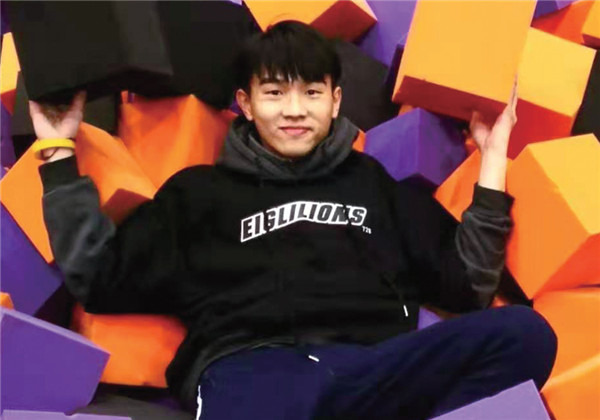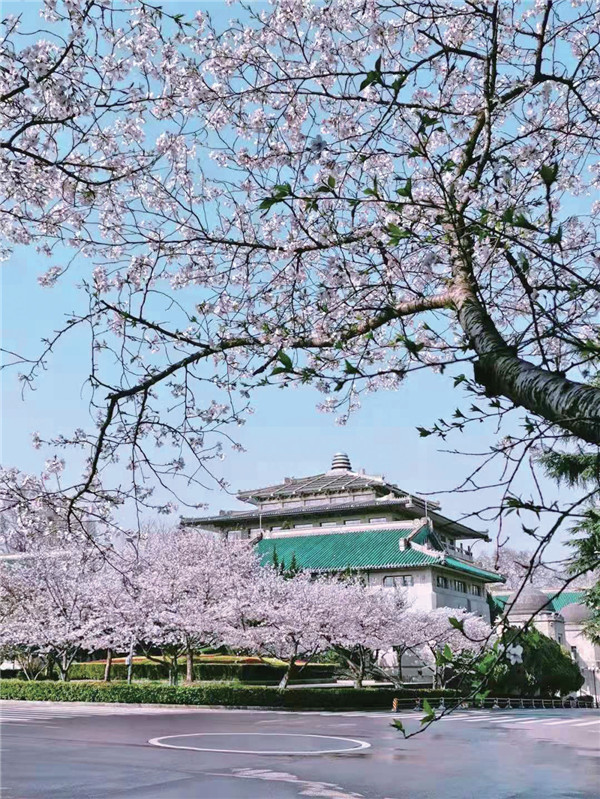我與漢字的美麗邂逅
〔馬來西亞〕 陳嘉揚 武漢大學

我依稀記得第一次接觸漢字的時候,橫平豎直的漢字讓我感到無趣、苦澀難懂,並且常抱怨漢字的複雜性,因為漢字的筆畫、偏旁部首和拼音千變萬化,一旦寫錯任何一項,所表達出來的意思就是截然不同的。直到來中國求學後,我才領悟到漢字的一撇一捺皆凝聚著中國古人的智慧結晶,漢字的一橫一豎皆浸染著中華民族的人文情懷、漢字的一筆一畫皆承載著華夏五千年文明的光輝歷程!

武漢大學 / 陳嘉揚提供
上個學期,我選修了國際教育學院開設的通識課——《漢字文化》。在這門課中,我仿佛走進了漢字的文化寶庫,並學習到了漢字的起源、演變、構造、藝術和文化等,讓我見識到了源遠流長的漢字史!漢字從甲骨文演變到楷書的漫長過程,反映了中華民族的美學追求,並且展現出了漢字深厚的文化意蘊。此外,不論是象形、指事、會意還是形聲,勾勒出的是漢字的筋骨和神韻。漢字就像一座橋梁,把我和中國聯結起來,讓我得以了解中國五千年以來生生不息的歷史脈絡。因為漢字,我學習到了博大精深的中國文化,比如“夫”字,它的本意是指成年人,即一個人上面有一杠,而杠就是簪子,而中國古人二十歲時需進行冠禮的儀式,用簪子把頭髮束起來,意味著來到成年人的階段了。此外,十二生肖裏的“龍”,華人之所以被稱為“龍的傳人”是因為原始部族都有各自的圖騰,隨著華夏民族逐漸地融合,各個民族的圖騰身上的特徵也融合在一起,就變成了“龍”,如龍的角像鹿角、眼睛像蝦眼、身體像蛇身、爪子像鷹爪等,反映了中華民族自古以來的相容並蓄。

武漢大學 / 陳嘉揚提供
漢字豐富含義的組合是其他文字所無法替代的,如中國著名的國産品牌——華為,意思是“中華有為”。宇宙的“宇”是四方上下,是空間單位,“宙”是古往今來,是時間單位,空間和時間合起來就是時空,即宇宙。漢字之美,不僅美在形體,也美在內涵,我們可以在日常生活中品讀漢字的風采:地名方面,中國很多地名皆蘊含著詩意,如長安、雲夢和金陵等;中藥名字方面有紫蘇、半夏、蟬衣等;天氣方面有芒種、白露、穀雨等;甚至每個月份皆有韻味的雅稱,如二月份有杏月、麗月和花月之稱。如今在我眼中,漢字不是僵硬的書寫工具,它富有感情、有色彩、有生命力。此外,我最喜歡的漢字是“陽”字,因為“陽”充滿著正能量,且寓意讓生命光芒萬丈!

武漢大學 / 陳嘉揚提供
感謝漢字,不僅讓我欣賞到了熠熠生輝的歷史文化面貌,也讓我觸摸到了中國的繁華!
時至今日,波瀾壯闊的華夏篇章還在不斷地書寫中……
My Beautiful Encounter with Chinese Characters
〔Malaysia〕 Tan Jia Yang, Wuhan University
I still remember the first time when I saw Chinese characters. Those square characters were boring and hard to understand. I often complained about the complexity of Chinese characters. The strokes, radical components andpinyin (pronunciation) of Chinese characters vary radically. Any minor difference might lead to quite different meaning. I started to realize the wisdom of Chinese characters in each stroke after I came to study in China. Each stroke in Chinese characters embodies the humanistic concerns and glorious 5,000-year civilization of China.
Last semester I took a general courseCulture of Chinese Character in the College of International Education as an elective course. I learned the origins, evolution, structure, art and culture of Chinese characters in this course, as if I walked into a culture treasure house. I started to know how long the history of Chinese characters was. From inscriptions on Oracle shells to regular script, the long evolution of Chinese characters displays the aesthetic pursuit of Chinese people as well as the cultural connotation of Chinese characters. Whether indicative, pictographic, pictophonetic or associative characters, they all display the muscles and charm of Chinese characters. Like a bridge, Chinese characters connect China with me, through which I began to understand the 5,000-year everlasting history of China. Through Chinese characters, I learned the charm of the broad and profound Chinese culture. For example, the Chinese character “夫” (Fu), means adult, and it is made up of the character “人” (means human) and two sticks (hair clasps), which vividly depicts a human whose hairs are bundled by hair clasps. In ancient China, an adult ceremony to bundle his hairs with clasps will be held for a kid when he turns 20. The Dragon“龍”(Long)in the 12 Chinese Zodiac embodies characteristics of multiple animals, such as horns of deer, eyes of shrimps, body of snakes and claws of eagles. This fully indicates the inclusiveness of different cultures of Chinese people. Therefore, Chinese people are also called the descents of dragons.
The rich connotations of Chinese characters are beyond comparison with other characters. For example, the world-known telecom manufacturer Huawei, whose Chinese name means Promising China;“宇宙” (Yu Zhou)means the universe, its first character “宇” (Yu) means a spatial unit and “宙” (Zhou) means a time unit, therefore, space and time being combined is the universe. The beauty of Chinese character lies not only in its physical structure, but also in its connotation. We can experience the charm of Chinese characters in our daily life. For example, there are lots of places being named with poetic charms, such as Chang’an (means everlasting peace), Yunmeng (means dreams on clouds) and Jinling (means golden hills); Chinese medicine names are also very poetic, such as Zisu (literally means purple leaves), Banxia (literally means mid-summer) and Chanyi (literally means the clothes of cicadas); for seasons, there are Mangzhong (literally means the time to plant grains), Bailu (means the time to have white dews) and Guyu (literally means grain rain); even every month has a beautiful name, such as February is called the month of apricot, the month of flowers or the month of beauty etc. Now in my eyes, Chinese characters are not only for writing and communication, and they are colourful, with emotions and vitality. I love“陽” (Yang, means sunshine) the most, because Yang means positive and shining!
Thanks to Chinese characters, which not only show me how vivid and glorious Chinese culture is, but also displays the prosperity of China.
Until now its splendour and glory is going on…



